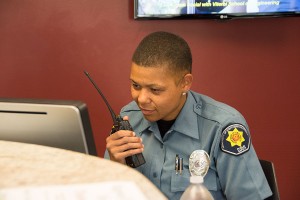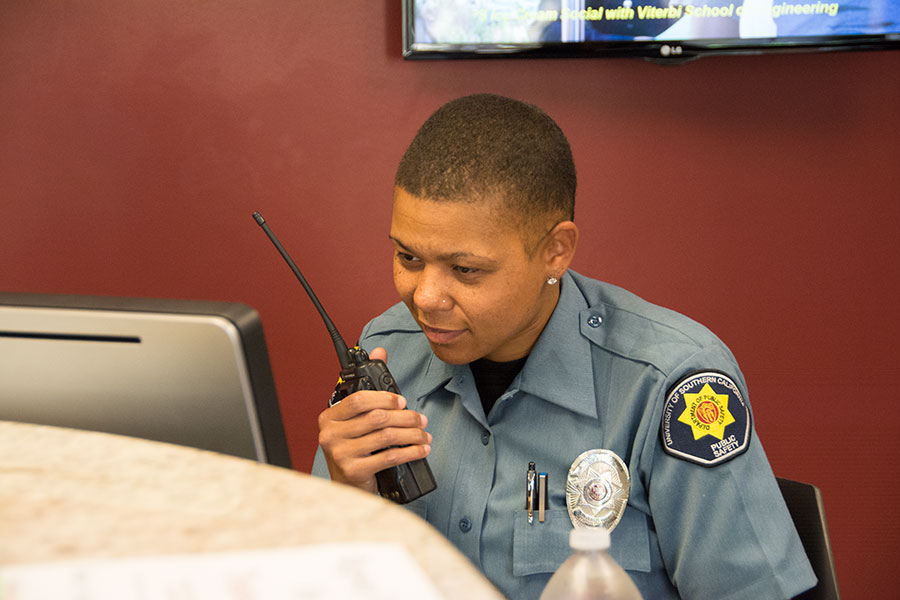Release of Clery Report shows updated statistics
The annual security and fire safety report released last week by the Dept. of Public Safety indicates that violent crimes, including burglary and robbery, have seen a substantial decrease. Reports of sexual assault, however, have increased, as have disciplinary referrals for liquor and drug violations.

On guard · Takoyah Penny, Dept. of Public Safety Community Service Officer, listens to a radio communication during her shift. DPS has increased its number of security ambassadors this year. – Mariya Dondonyan | Daily Trojan
The report, released each year in compliance with the Jeanne Clery Disclosure of Campus Security Policy and Campus Crime Statistics Act, requires college campuses to document three calendar years of specific campus crime statistics, including security policies and procedures.
This year’s report is the first released since the university hired Martha Walters as the Clery Compliance Coordinator earlier this year. Walters, who was the main individual responsible for authoring the report, said one big improvement the university has seen is a 47 percent decrease in robberies since 2011.
DPS Chief John Thomas said the majority of robberies occur off campus, but he believes DPS’s weekly communication in statistics meetings, called CommStat, are partly responsible for the decrease, and that students are becoming more informed about how to stay safe off campus.
In recent years, DPS officials, officials from the Los Angeles City Attorney, LAPD officials, Exposition Park police and Figueroa Corridor personnel have worked together to participate in the CommStat weekly strategy meetings about area crime.
“Probably the biggest factor is the continuing educational effort and the investment that the university has made into technology,” Thomas said. “Also our CommStat process where we put together strategies based upon what crimes are reported [help us] deploy our resources based upon those factors.”
Thomas said he believes that closing campus to the public between 9 p.m. and 6 a.m., as well as the addition of at least 60 security ambassadors from 4 p.m. to 6 a.m. seven days a week has helped decrease burglaries, particularly in on-campus residential facilities.
He noted, however, that security measures including card swipes and biometrics in on-campus residential facilities have also led to an increase in liquor- and drug-related referrals because there are more security personnel stationed in the dorms.
“Now that you have all the increased security in the residence halls, they’re now seeing more people come intoxicated, and they’re making the notification to get them some medical assistance,” Thomas said. “Before when you didn’t have that, a student could bring their intoxicated roommate right up to the room and nobody would know any better.”
The number of reported sexual assaults has increased within the last few years. Reported sexual assaults, listed in the report as forcible sex offenses, went from 24 in 2011 to 32 in 2012 to 33 in 2013. Last year’s report made adjustments for forcible sex offenses, a change not noted in the previous year’s report.
DPS Deputy Chief Carlisle said he expects the numbers to continue to fluctuate in part because effective Oct. 1, 2013, the Center for Women and Men, which provides counseling for victims of sexual assault, was no longer designated as a Campus Security Authority, the title given to entities that can file official reports of sexual assault.
“The university wanted to make sure that nothing would discourage a victim of sexual assault from reporting to the Center for Women and Men,” Carlisle said. “We anticipate there will be a decrease in the reported numbers next year.”
Walters noted that the Clery Act stipulates that instances of sexual assault are recorded in the year they are reported. So if a student comes to DPS and reports being sexually assaulted the year prior, it would still fall under this year’s report. She also said this year’s report outlines more information about resources for victims of sexual assault and steps victims can take.
Thomas said that an increase in the number of reported sexual assaults can actually be a positive thing because it means more students are willing to report the crime.
“When it comes to sexual assaults, I’m actually glad that we’re getting more students to come forward and report because it gives us a better perspective of how widespread the issues are, and we can be better equipped to assist in helping do something about it,” Thomas said.
This year’s report also includes categories for domestic violence, dating violence and stalking. The Violence Against Women Reauthorization Act requires that, as of Jan. 1, 2014, colleges and universities begin collecting data about instances of domestic violence, dating violence and stalking.
USC included some data they collected in those three categories in this year’s report, but officials do expect the numbers to increase once they have more data for next year’s report.
The 58-page report takes time and effort to produce, but Walters noted it gives students and parents an opportunity to compare crime data from different universities.
“I think that directing resources to put together this report requires a university to come together as a whole, the many facets of it — student affairs, student judicial conduct, administration and your department of public safety — to put this information together to put it out there to the public for consumption,” Walters said.
Thomas said that the report gives an overview of USC’s security and allows students to make informed decisions regarding their personal safety.
“Despite incidents that may make the news, that we look at as those things that can happen anywhere in America, the reality is this allows a context,” Thomas said. “If people take the time to read it and digest it and use it for what it’s worth to make an educated decision as to whether or not the university environment is safe, it will give them the tools they need to make the decisions that are best for them.”

